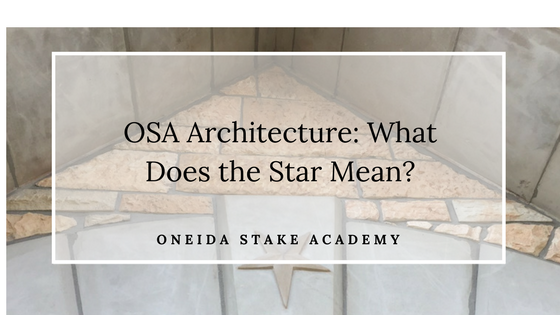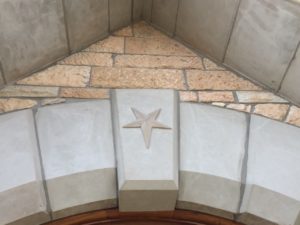
OSA Architecture: What Does the Star Mean?
The original craftsmen who constructed the Oneida Stake Academy building at 90 E. Oneida, Preston, left clues that reveal their esteem for education.
Even without the aid of electricity, the 128-year-old building’s rooms are full of light. Not only is the academy’s design grand, it invites visitors to look up. And when they do they can see among the hand-chiseled stone an interesting symbol above the front door: an inverted star. It is a unique inverted star, whose bottom ray extends beyond the length of the other four points.
John Lambert, Founder and president of Abstract Masonry Restoration, Inc., has made it a hobby to discover the meaning of symbols often included on early architecture.
“Most star symbols on religious architecture have either five, six or eight points. This one has five and is quite unique because the star is not only inverted (one of the rays pointing directly downward as opposed to being situated upright), but also the ray pointing downward is accented by being slightly elongated,” he has said.

According to The Day Star: Reading Sacred Architecture, by Val Brinkerhoff, said Lambert, five-pointed stars have usually been used to represent people of differing intelligence, righteousness, and glory.
“To me, this feels appropriate when considering the variety of students who came to the building to learn,” said Lambert.
And varied they were. Preston was a frontier town full of farmers and ranchers. Poverty prevailed. Teachers gave of their own means to keep the school running. Students did their part, too, “through activities such as musical programs and skits with other teachers to offset academy costs. They also visited wards in the Oneida Stake and gave talks on education, which included the advantages of attending the academy,” wrote Fred Woods in the Spring 2003 edition of Mormon Historical Studies.
Tuition was charged, but “none were excluded,” for their ability to pay. It was noted that a note remained on the school’s books for tuition to two boys who went on to become doctorates.
At different times, the school was used to teach children of all ages – primary ages to graduate ages. Indeed they were of “differing intelligence,” as the star symbol suggests.
But this star is inverted and such a star symbol is often tied to Christ, as the light and life of the world. And that elongated ray which points downward “appears to be Christ’s light extending toward each person entering the building,” said Lambert, referencing Brinkerhoff’s book.
“Because the objective of the church in creating academies grew out of the desire church leaders had that the youth be taught the principles of the church as a part of their school curriculum, it appears to me that this star symbolizes students of differing intelligence, righteousness, and glory entering a building where those three things can be expanded by Christ – the light and life of the world.
“I can’t imagine how cool it would have been to have someone explain that to me if I were a Mormon student entering that building to be taught. What a mindset to have when beginning one’s day,” said Lambert.
Lambert’s research and conclusions are in agreement with the few, recorded sentiments of the Oneida Stake Academy’s role in the community.
The original intent of the 36 academies built by members of The Church of Jesus Christ of Latter-day Saints was to spiritually fortify Latter-day Saint youth in a society in which Mormons had been disenfranchised by a federal government opposed to their doctrine. They found in these schools a way to maintain the instruction of their beliefs.
An essay, written by Peter Simon Jensen in about 1895, reveals the attitude held towards the academy and the education offered there when that unique star was carved:
“As the sole object of building them is that all of a moral character who wish and are able to pursue its courses with profit may be benefited and develop their mental facilities in every direction. Everything that terminates to elevate us originates from God our Eternal father, development of the head and mind is necessary. And Church schools are the agency which this shall be brought about.”